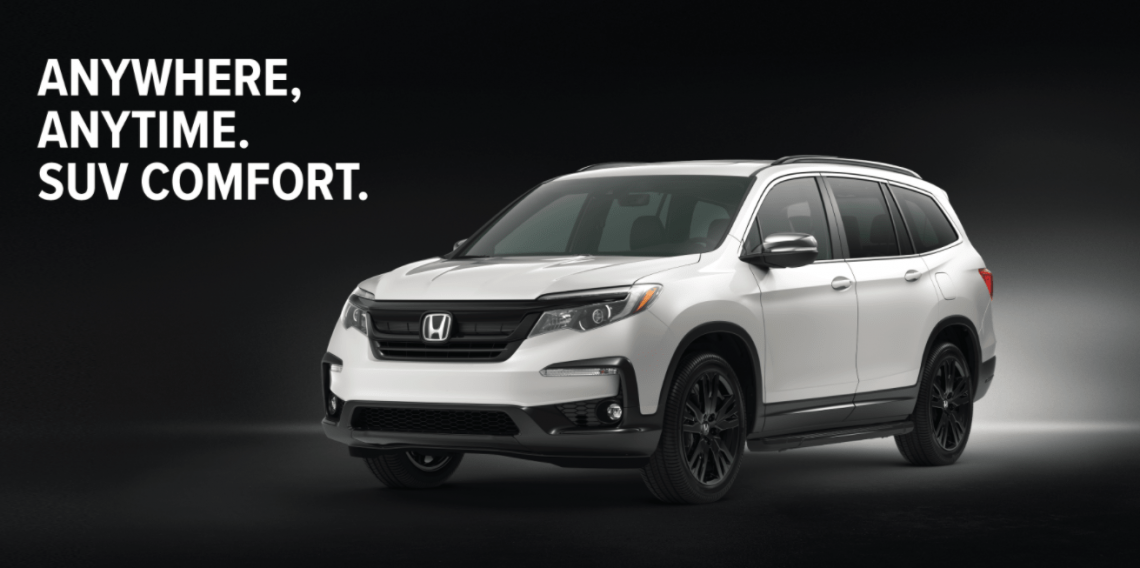Asphalt
In addition to the V6 PI, VTEC engine from the Earth Dreams Technology family with a VCM valve cut-off system, the Mideast version of the Honda Pilot received brake discs increased to 330 mm in diameter, a ground clearance of 200 mm (instead of 185 mm in the American market), additional noise insulation, remote engine start, heated steering wheel, heated front and rear seats.
Also, the suspension was reconfigured for our not the best roads in the world. However, the suspension travel remained small, and on broken primers with random inserts of asphalt, the car shakes. Yes, this is not a Land Cruiser Prado, on which you don’t have to slow down at all, jumping off the highway onto a country road.
On the other hand, in the city and on the track, the Honda Pilot moves smoothly without a hint of “American” swing, like the Chevrolet Tahoe. No pecks when braking or sickening lulling on the waves.
The car released by Honda KSA feels like a monolithic block, despite its immense size. There are several reasons:
- Good weight distribution along with the axles;
- Increased body rigidity and suspension attachment points;
- A decent wheelbase in length.
Pushing in traffic jams on the Honda Pilot is not annoying, but grace comes as soon as you leave the road: quiet, soft, respectable. And you don’t want to rush anywhere.
What is Inside?
The new Honda Pilot feels more premium than the utilitarian one it used to be. The interior is equipped with high-quality finishing materials, a modern instrument cluster with a colour TFT display.
The main thing is the enormous 8-inch touchscreen, which is the centre of the Honda Connect multimedia system. One of the “tricks” of multimedia that works on the Android system is installing a variety of applications.
The multimedia equipment is quite impressive: 4 USB-inputs, 2 HDMI-inputs, AUX-input, DVD-player, Wi-Fi hotspot, 9-inch widescreen colour screen for rear sofa passengers, ten speakers that all together give a decent sound quality. In other words, everything that was sorely lacking in the second generation Honda Pilot has appeared in this car.
These are all lovely modern details, but the Pilot’s real upgrade is its internal volume and the cabin’s ergonomics. The big-box between the front seats has not gone anywhere, and it feels even more enormous. A full-fledged tablet computer, a reflex camera with a professional lens, a lady’s bag full of all sorts of necessary and unnecessary things will fit in there …
The driver’s seat is adjustable in 8 directions so that a driver of any height can adjust themselves to a comfortable fit, be it a basketball player or a fragile little human.
Excellent forward view – you can control the “blind” zone far away from you with the help of a high-resolution camera built into the side mirror: when you indicate the right turn, the image is transmitted to the central 8-inch screen. Of course, the Honda Pilot also has a rear-view camera, which has three modes of operation.
The second row of seats is no less pleasant than the front. Passengers can set themselves a comfortable temperature (the temperature is three-zone!), Adjust the inclination of the seat back, and create a more intimate atmosphere by covering the windows with curtains. There is enough legroom, and if it turns out that it is cramped, you can move the chair back a little, thereby reducing the free space for those in the third row.
Interestingly, the volume of the trunk with three rows of seats raised is a decent 305 litres. Let me remind you that the previous “Pilot” has a much more fair value – 217 hp. If the third row is folded, then the useful cargo volume increases to 827 litres.
Offroad
Off-road “Pilot” is not as powerless as it might seem at first glance. The Japanese did not sacrifice the vehicle’s cross-country ability. Otherwise, how will the Arabs ride on the sands, and the Europeans go to the “dacha” along the country road? For the Americans, all-wheel-drive is not particularly needed because a version with traction only for the front wheels is available for them.
The Honda Pilot’s all-wheel-drive system is called the iVTM-4 and features traction control to each wheel. There are no inter-axle and inter-wheel differential locks – the moment is dosed by the couplings.
The Pilot has 4 operating modes for this system: “normal”, “snow”, “mud”, “sand”. Oddly enough, all these modes work.
What’s the Bottom Line?
Honda has bumped up the already big SUV by adding more options to the car. The car has become noticeably more comfortable, smoother in motion, a little more economical.
It’s perfect for you if:
- You drive around with more than two people;
- Wi-Fi and other multimedia accessories delight you;
- You’re not an extreme driver.


